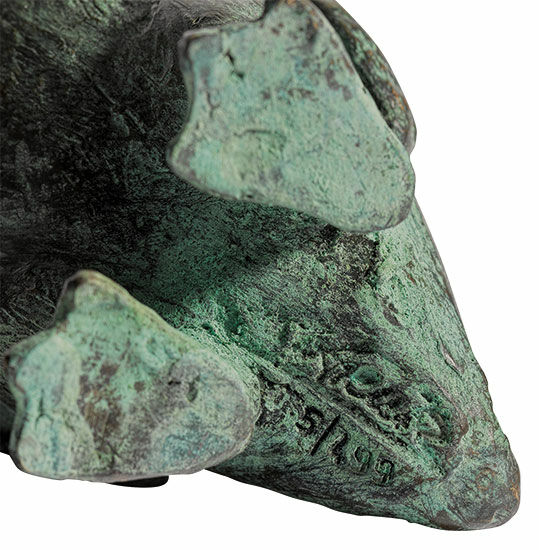Sculpture "Penguin", bronze
Sculpture "Penguin", bronze
Quick info
ars mundi Exclusive Edition | limited, 499 copies | numbered | signed | bronze | patinated | polished | size approx. 14.5 x 7.5 x 8.5 cm (h/w/d) | weight approx. 1.2 kg
Detailed description
Sculpture "Penguin", bronze
The German sculptor Kurt Arentz (1934-2014) was able to bring his very own touch to the classical subject of animal sculpture. Although Arentz always emphasised the typical features of the animals, he never strove for perfection. He left the surfaces uneven and visibly structured, thus giving each of his figures a very individual character. This is also evident in this study of a penguin.
Kurt Arentz had made a name for himself worldwide with bronze sculptures and busts. In 2001 he received the Order of Merit of the Federal Republic of Germany. Furthermore, he was the recipient of numerous prizes and many of his works can be admired in public spaces in Europe and America.
Fine bronze sculpture, cast in Lost-Wax-Process, patinated green-grey by hand and polished. Limited world edition 499 copies, numbered and signed. Size approx. 14,5 x 7,5 x 8,5 cm (h/w/d). Weight approx. 1.2 kg. ars mundi Exclusive Edition.
Customer reviews
Der Pinguin bereitet allgemeine Freude und der Versand durch ars mundi verlief einwandfrei.

About Kurt Arentz
1934-2014
The German sculptor and painter was born in 1934 in Cologne, as the son of an old-established Bergisch artisan family. He initially learned a trade but then found his own artistic path from 1979 onwards.
At first, he created still lifes in oil and pastel as well as portraits in bronze of celebrities such as Franz Josef Strauß or Herbert von Karajan. Later, he focused mainly on animal motifs emphasising the typical character of each species. As a remarkable self-taught artist, Kurt Arentz found his very own artistic form concept. Beyond academic experiments, but also far from all naturalistic platitudes, he shaped symbols of vital nature with his hands. His ideals of a still-intact world transport us as if into the wilderness. Arentz abstracted the animal as a being in itself. In doing so, he succeeded in placing his works in an era of timeless validity.
For his works, Kurt Arentz used a special silicone rubber process that allowed for the immediate realisation of his ideas. The bronze cast was then signed with the artist's very own signature. In the final work step, the surfaces of the metal were polished, roughened or patinated, thus acquiring their motif-typical characteristics.
The sculptor has already presented his works to a large audience in numerous exhibitions in Germany and France. On his 70th birthday on May 30, 2004, Kurt Arentz was congratulated by former chancellor of Germany Helmut Kohl and former German President Roman Herzog. Arentz was used to receiving frequent acknowledgements and tributes from celebrities: Other fellow statesmen such as Willy Brandt, Ronald Reagan or George Bush Sr., as well as Sir Peter Ustinov and Willy Millowitsch, had their portraits painted by Kurt Arentz.
Nevertheless, Kurt Arentz's great mastery is evident in his animal sculptures. He is considered one of the most significant animal sculptors of the 20th century. In 2001, Arentz was awarded the Order of Merit of the Federal Republic of Germany for his artistic and social commitment. His sculptures are housed in places such as the White House, Washington, and the Museum of European Art in New York.
Like no other, he succeeded in reaching the very essence of the animal and depicting it. The great popularity of these nature studies lies in their strong expressiveness, but also in their carefree cheerfulness: Arentz's creative energy is joy in life.
Kurt Arentz lived and worked in Leverkusen. He passed away in June 2014.
An alloy of copper with other metals (especially with tin) used since ancient times.
When casting bronze, the artist usually applies the lost-wax technique which is dating back more than 5000 years. It's the best, but also the most complex method of producing sculptures.
First, the artist forms a model of his sculpture. It is embedded in a liquid silicone rubber mass. Once the material has solidified, the model is cut out. The liquid wax is poured into the negative mould. After cooling down, the wax cast is removed from the mould, provided with sprues and dipped into ceramic mass. The ceramic mass is hardened in a kiln, whereby the wax flows out (lost mould).
Now we finally have the negative form, into which the 1400° C hot molten bronze is poured. After the bronze had cooled down, the ceramic shell is broken off and the sculpture is revealed.
Now the sprues are removed, the surfaces are polished, patinated and numbered by the artist himself or, to his specifications, by a specialist. Thus, each casting becomes an original work.
For lower-quality bronze castings, the sand casting method is often used which, however, does not achieve the results of a more complex lost-wax technique in terms of surface characteristics and quality.
Graphic or sculpture edition that was initiated by ars mundi and is available only at ars mundi or at distribution partners licensed by ars mundi.
Term for an art object (sculpture, installation), which is produced in multiple copies in a limited and numbered edition according to the artist‘s will.
Artist's multiples have been called the most accessible and affordable art on the market.
A plastic work of sculptural art made of wood, stone, ivory, bronze or other metals.
While sculptures from wood, ivory or stone are made directly from the block of material, in bronze casting a working model is prepared at first. Usually, it is made of clay or other easily mouldable materials.
The prime time of sculpture after the Greek and Roman antiquity was the Renaissance. Impressionism gave a new impulse to the sculptural arts. Contemporary artists such as Jorg Immendorf, Andora, and Markus Lupertz also enriched sculptures with outstanding works.






